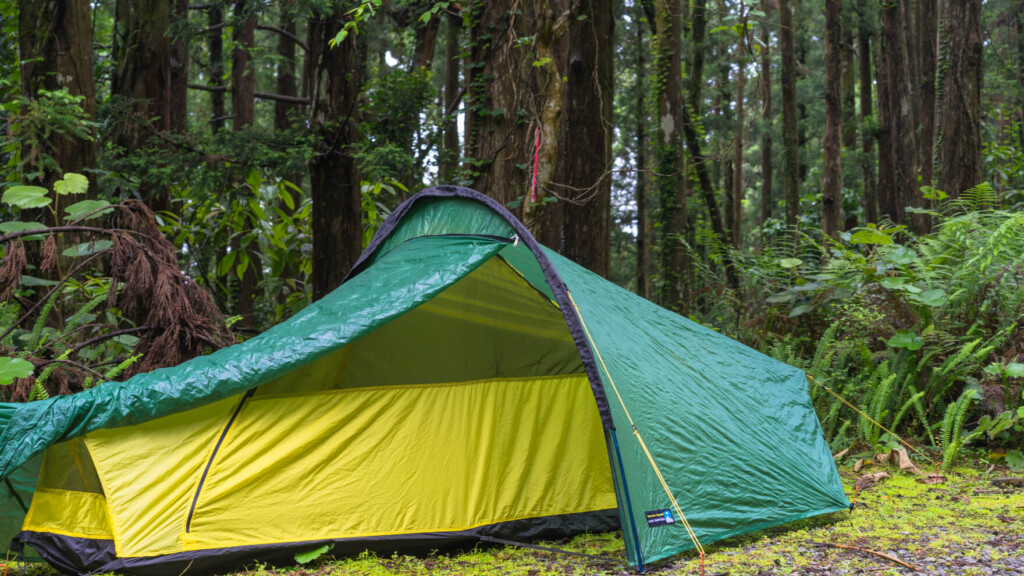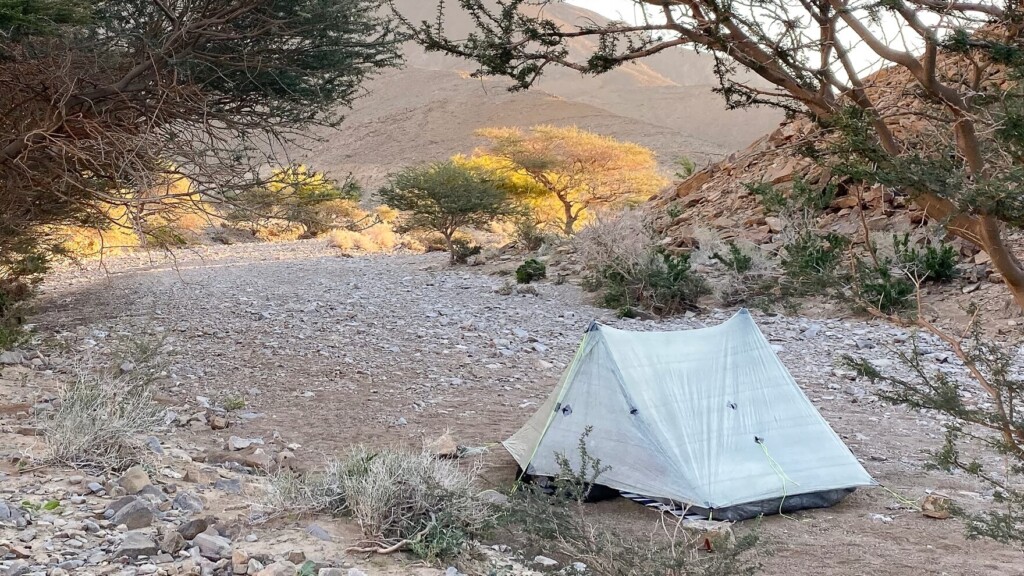Today, there are tents known as lightweight, but the Laser Lite released by Terranova , was the first in the tent market to deliver products that fell below 1kg, and was certified by the Guinness Records as a lightweight tent. After its release, it won various awards, and Terranova became the standard for lightweight tents and achieved a pioneer position in the light tent world.
The Racer Competition 1 we will be reviewing this time , is the successor to the Laser Lite, and although it has little to change in weight since its release, it is not as surprising as it was back then, we have accumulated updates to improve safety and durability.
We will share the current state of this tent, which changed the history of lightweight tents, along with reviews of actual use.
table of contents
Rough features of Racer Competition 1
Racer Competition 1, which has been on sale for many years by Terranova, a pioneer lightweight tent, is now often hidden in the shadows of ultra-light tents that weigh less than 500g, such as the Laser Pulse Ultra 1, which the company sells, but it has durability and weather resistance that tents that are completely leaning towards light weight. It is a very balanced and cost-effective model that stands out for even more reasonable pricing than its performance.
The fly and floor materials have a water pressure resistance of over 5,000mm, and are well equipped with windproof measures, and are designed to be set up quickly and smoothly, making them suitable for use in mountainous scenes, and appeals to high performance that will satisfy a wide range of people, from mountaineers to adventure racers and through hikers who walk for a long period of time.
This time we are using the previous model to review it. Just to be safe, I borrowed the latest version of the sample from the manufacturer to check it, but since the basic construction is the same with only updating the details, I will mention the changes as needed in the main text.
Recommended points
- Simple structure reduces setup time
- High weather resistance
- Lightweight to less than 600g due to fast packing system
Points that interest me
- Too stoic indoor
- There is no ventilation
Main Specifications and ratings
| item | Specifications and ratings |
|---|---|
| Number of people to sleep | 1-2 people |
| color | green |
| Official minimum weight | 860g (970g including pegs and storage bag) |
| Actual measured weight | 1024g (1117g including pegs and storage bag) |
| Fry material | Sil Nylon RipStop (Water Resistant: 5000mm) |
| Floor material | Sil Nylon RipStop (Water Resistant: 6000mm) |
| Pole material | DAC 8.55mm Fatherlite |
| size | Width 220 x Depth 62/93 x Height 45/95cm |
| Storage size | Main body: 12 x 42 cm, pole cm |
| Floor area | 1.3㎡ |
| Front room area | 0.5㎡ |
| accessories |
|
| option |
|
| Living comfort | ★★☆☆☆ (If you use a solo version, ★★★☆☆) |
| Ease of setup and removal | ★★★★☆ |
| Weather Resistant | ★★★★★ |
| Durability | ★★★☆☆ |
| weight | ★★★★★ |
| Portability | ★★★★☆ |
| Versatility | ★★★☆☆ |
| comprehensive evaluation | ★★★★☆ |
Detailed review
Simple structure reduces setup time
The parts are the main body, fly, 3 poles, and 10 pegs. The storage bag is large and can be stored in one bag, but by storing the poles separately, the main body and fly can be grouped together in small pieces. The storage bag is made of sil nylon, so it is easy to slip and take out.
The pole is a DAC 8.55mm Fatherlite, and is measured at 147g. The pole is not independent and is set up in one unit, so the weight is considerably reduced. Two auxiliary poles are included to make the fly taller. This auxiliary pole is made of carbon and weighs 22g each.
*The auxiliary pole in the updated version has been changed to aluminum.
The pegs are made of titanium (5g each) and come with 10 pcs. However, these pegs are quite thin, so even though they are made of titanium, I take care when it is thrust...
*We were unable to confirm the new pegs, but the manufacturer's website shows 11g aluminum x 11 pieces.
The tent is a tunnel-shaped non-self-supporting system. At first glance, it may seem complicated, but once you understand the mechanism, it has a very simple structure. To set up, first pass the pole through the fly sleeve.
The sleeve that holds the poles is covered with reflective material, making it easier to see even when in the dark.
Use the auxiliary poles on both ends of the long side and fasten them with pegs to make them stand on your own. It can be set up relatively easily even in strong winds.
All you have to do is hang the inner tent from inside the fly, secure each point with pegs, and then install it. Unlike self-supporting, it must be firmly secured with tension pegs.
I'm a bit dissatisfied with the livability...
The room is spacious enough when used as a "solo tent." In this regard, it is no match for solo tents from other manufacturers. However, since the manufacturer is for 1-2 people, I hope they will have space for two people to stay, but it's quite tough for two people... First of all, there is no space to lay two mats. There are triangular meshes of the same size at the feet and pillow.
The room is completely normal, with no headlamps or loops for hanging strings or small items inside.
The longest vestibule is 50cm wide, so as long as it is used as a solo tent, it can be affordable as long as you want to put food and luggage. Contrary to the room, even two people can relax in the front room. I wish there was a little more balance with the room...
It has the impression that it is neither breathable nor unavailable. Half of the entrance to the inner tent is made of mesh, so if you roll the fly, it will be better to vent well, but once you close the fly, the outside vents will disappear, and depending on the season, it is expected to be quite humid. Furthermore, since it is impossible to block mesh in all three places, it seems like wind will come in and it will get cold in winter. As with the manufacturer's specifications, it would be appropriate to use it for three seasons.
Impressions of actually using it
High performance as a solo tent
The manufacturers use one or two people, but no matter how you look at it, it's cramped for two people to sleep together. The only expected use of two people would be mountain races. Anyway, I want to sleep without getting wet during the race! When an essential equipment includes a tent, this tent is lightweight, compact, and designed to be resistant to wind and rain, making it the perfect tent.
However, only a handful of people use it that way. For normal use, it should be considered a solo tent. Lightweight below 1kg, high weather resistance, and quick setup, providing a high overall balance and high performance. Living is not bad either. The first setup involves hanging the inner tent, but after that, it can be removed as is, so the setup will be quite quicker afterwards. The manufacturer claims that the setup time is 5 minutes, but this number is pretty impressive. Once you get used to it, you can set it up in 5 minutes.
There is also a fast packing system that can be used by Zert as a floorless tent that does not use an inner tent, and with this system, it is lighter than 600g, even with poles. It can be used more ultralight, and requires no need to carry both tents and zelts, so it's two birds with one stone.
Storage is also compact. The storage bag is made to match the length of the pole, so if you store the pole separately, the main body and fly will be quite compact.
*Currently, racer compact is also on sale, and although it is the same weight, it can store the poles about 2/3, making it more compact. The price is almost the same.
The fries have a double zipper so if you open them from above, they don't trap any air when cooked in the rain and are ventilated perfectly.
However, the ventilation inside is not very good. If you're in good weather or are thinking about it, if you roll up the fly, half of the entrance is mesh, so there's plenty of ventilation, but once you close the fly, you'll have to rely on the small mesh at your feet and pillow, and no air circulates at all. In the hot and humid Japanese climate, air circulation is insufficient.
*The new fly has mesh in the same place as the mesh part at the feet and pillow, improving breathability. The inner mesh can now be closed with Velcro. This is probably the most updated part. A small roof is placed on top of the fly mesh to prevent rain from entering.
I'm also worried about durability. The fabric has weak seams, and the areas where tension was already deteriorated after several uses were applied. We also use a lot of rubber parts, such as the parts that connect the fly and the inner tent, so we are worried about it getting worse.
Another special note is the pole cover. By covering the fly pole sleeve with this, it becomes less susceptible to wind resistance and is more wind-resistant. If you know that you will only use it in areas that are not affected by wind, such as forests, remove it to reduce the weight (in grams).
Summary: Recommended for people like this
In any case, it is made of lightweight, has a high balance of weather resistance and strength. It stands firmly even in strong winds, so you can use it without worrying about it even in high-altitude swells where the wind blows. The manufacturer's specifications are limited to two people, but unless you are particularly stoic, consider it a solo tent. As for the adaptation season, it would be best not to consider winter use, as the manufacturer claims it will be three seasons. It would be tough in summer if the temperature is high and humid. It is aimed at mountains from spring to autumn. However, the updated version seems to have improved breathability a little, so it may be comfortable to use even in the summer in Japan.
Ultralight fans want to make the tent lighter, but rather tarp and zert, and traverse for days and fast hiking to go far. Racer Competition 1, which has not been sacrificed by important points, is perfect for such people. It's a choice you won't regret.


